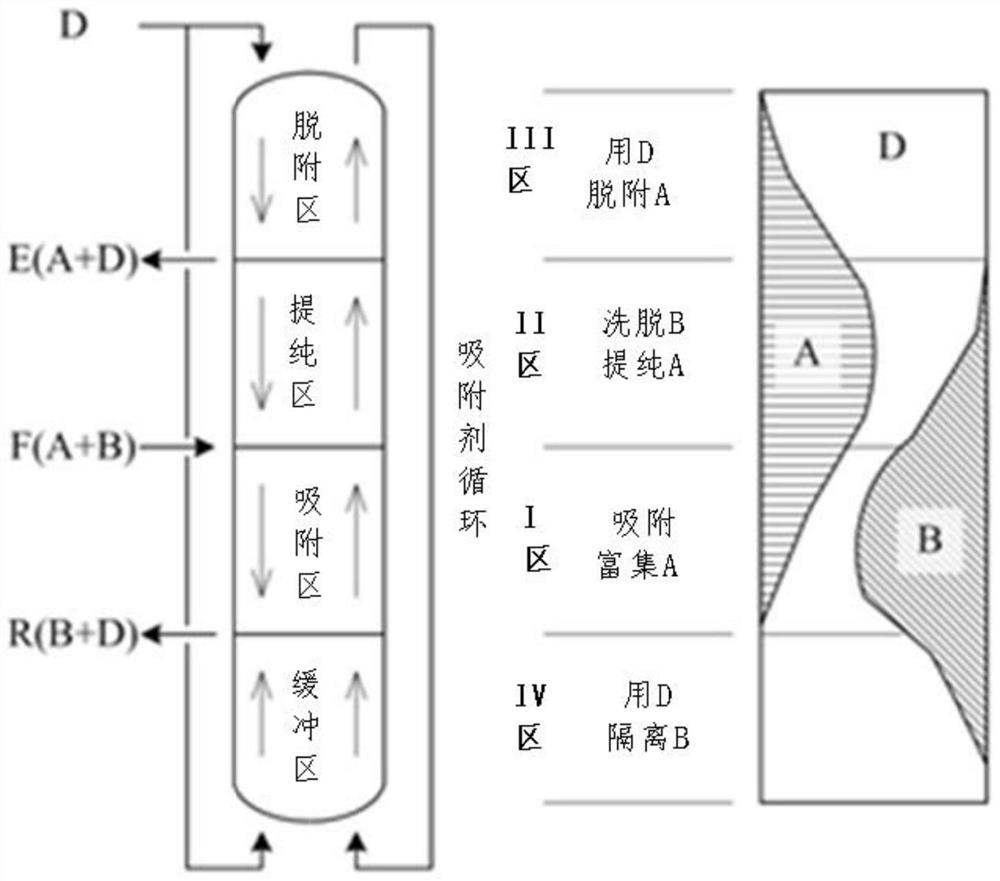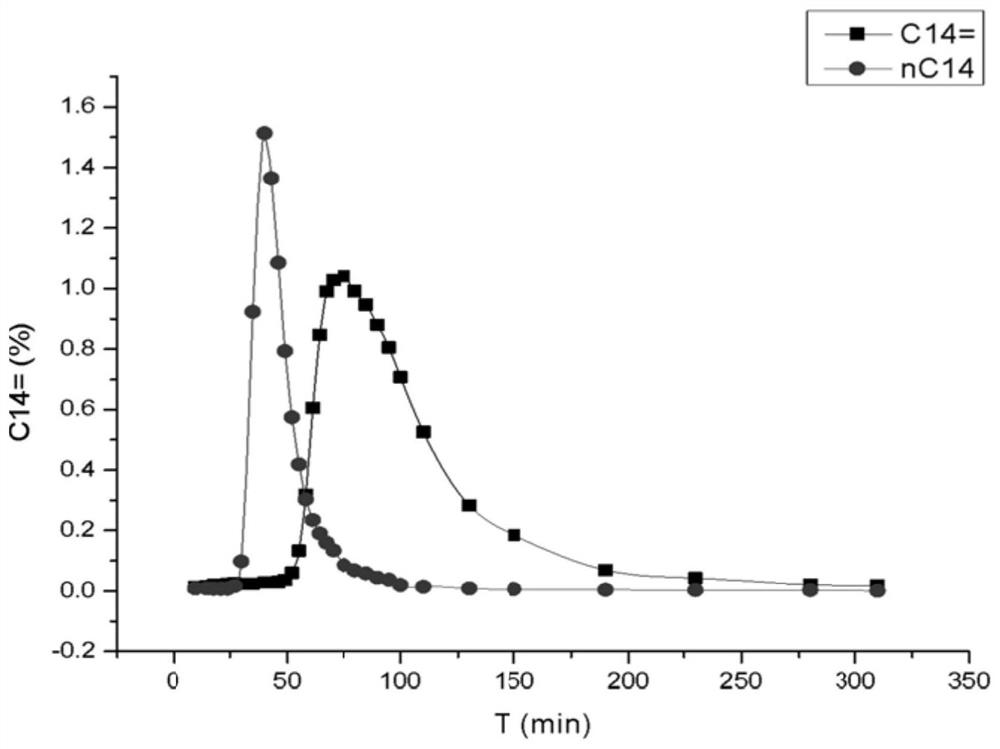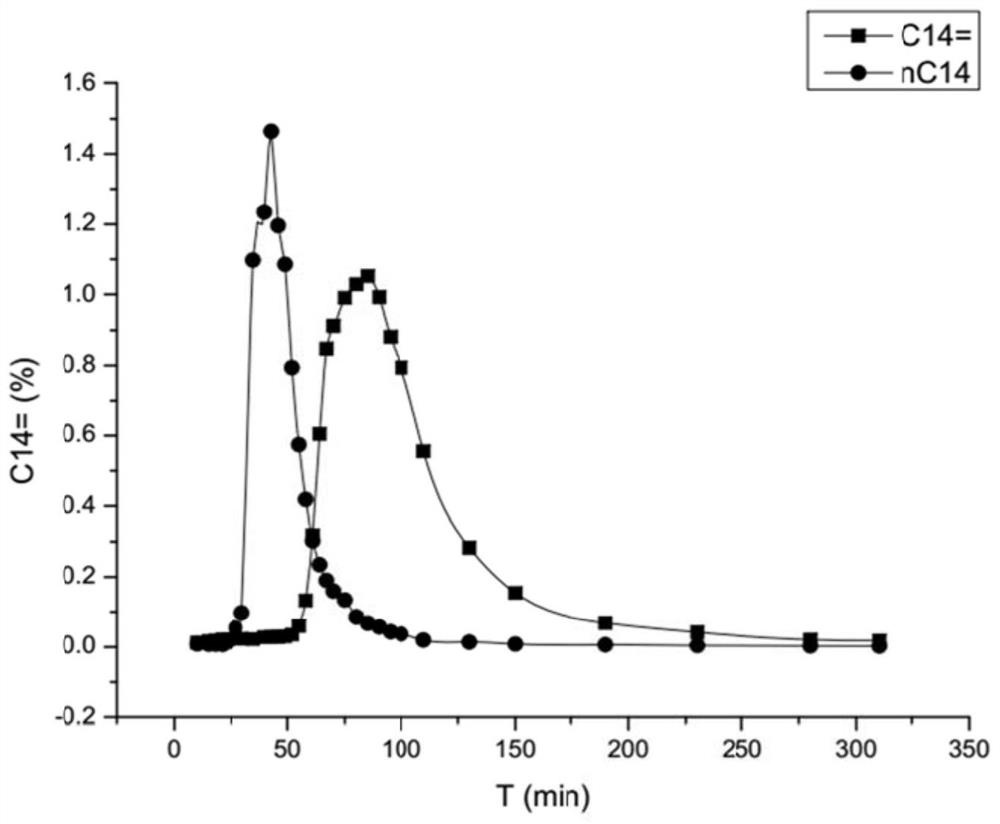Method for separating alkane and olefin by using simulated moving bed
A technology for simulating moving bed and olefins, applied in adsorption purification/separation, organic chemistry, etc., can solve the problems of large amount of eluent, high cost of eluent, long separation time, etc. cost-effective effect
- Summary
- Abstract
- Description
- Claims
- Application Information
AI Technical Summary
Problems solved by technology
Method used
Image
Examples
Embodiment 1
[0046] In this embodiment, the raw material to be separated is C14 component, and the eluent is C10 paraffin.
[0047] C14 raw materials: n-tetradecane 30% (w / w), 1-tetradecene 70% (w / w), before the alkanes are separated, the raw materials are pretreated to remove poisons that may cause adsorption failure ( such as oxygenated organic compounds, benzene, water, etc.).
[0048] C10 eluent: n-decane. Before alkanes are separated, the eluent is pretreated to remove poisons that may cause adsorption failure (such as oxygen-containing organic compounds, benzene, water, etc.).
[0049] Separation of the C14 feed was performed in a simulated moving bed unit using the C10 eluent. Operating conditions of the simulated moving bed: molecular sieve adsorbents and not limited to modified molecular sieve adsorbents are used as the adsorbent; the operating temperature is 250°C; the operating pressure is 2Mpa.
[0050] The distribution of C14 in the simulated moving bed adsorption tube is as...
Embodiment 2
[0055] In this embodiment, the raw material to be separated is C14 component, and the eluent is C16 alkanes.
[0056] C14 raw materials: n-tetradecane 30% (w / w), 1-tetradecene 70% (w / w), before the alkanes are separated, the raw materials are pretreated to remove poisons that may cause adsorption failure ( such as oxygenated organic compounds, benzene, water, etc.).
[0057] C16 eluent: n-hexadecane. Before alkanes are separated, the eluent is pretreated to remove poisons that may cause adsorption failure (such as oxygen-containing organic compounds, benzene, water, etc.).
[0058] Separation of the C14 feed was performed in a simulated moving bed unit using the C16 eluent. Operating conditions of the simulated moving bed: molecular sieve adsorbents and not limited to modified molecular sieve adsorbents are used as the adsorbent; the operating temperature is 100°C; the operating pressure is 1Mpa.
[0059] The distribution of C14 in the simulated moving bed adsorption tube is...
Embodiment 3
[0064] In this embodiment, the raw material to be separated is C10 component, and the eluent is C16 alkanes.
[0065] C10 raw material: n-decane 30% (w / w), 1-decene 70% (w / w), before the alkanes are separated, the raw material is pretreated to remove poisons that may cause adsorption failure (such as containing oxygen organic compounds, benzene, water, etc.).
[0066] C16 eluent: n-hexadecane. Before alkanes are separated, the eluent is pretreated to remove poisons that may cause adsorption failure (such as oxygen-containing organic compounds, benzene, water, etc.).
[0067] Separation of the C10 feed was performed in a simulated moving bed unit using a C16 eluent. Operating conditions of the simulated moving bed: the adsorbent adopts molecular sieve adsorbent and modified molecular sieve adsorbent; the operating temperature is 180°C; the operating pressure is 0.5Mpa.
[0068] The distribution of C10 in the simulated moving bed adsorption tube is as follows: Figure 4 shown...
PUM
 Login to View More
Login to View More Abstract
Description
Claims
Application Information
 Login to View More
Login to View More - R&D
- Intellectual Property
- Life Sciences
- Materials
- Tech Scout
- Unparalleled Data Quality
- Higher Quality Content
- 60% Fewer Hallucinations
Browse by: Latest US Patents, China's latest patents, Technical Efficacy Thesaurus, Application Domain, Technology Topic, Popular Technical Reports.
© 2025 PatSnap. All rights reserved.Legal|Privacy policy|Modern Slavery Act Transparency Statement|Sitemap|About US| Contact US: help@patsnap.com



